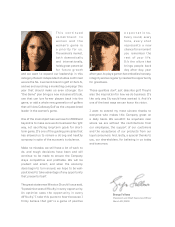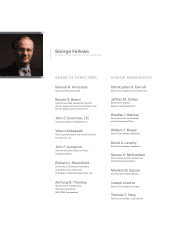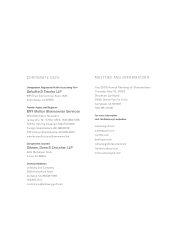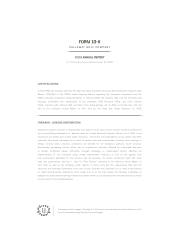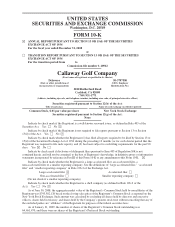Callaway 2008 Annual Report Download - page 17
Download and view the complete annual report
Please find page 17 of the 2008 Callaway annual report below. You can navigate through the pages in the report by either clicking on the pages listed below, or by using the keyword search tool below to find specific information within the annual report.into existing locations within and outside of the United States. As a result of these initiatives, in May 2008, the
Company announced the closure of its golf ball manufacturing facility in Gloversville, New York. See Note 5 to
the Consolidated Financial Statements, “Restructuring and Integration Initiatives.” Overall, although a significant
amount of labor is still used in the golf ball manufacturing process, the golf ball manufacturing process is much
more automated than the golf club assembly process.
The Company purchases raw materials from numerous domestic and international suppliers in order to meet
scheduled production needs. Raw materials include steel, titanium alloys and carbon fiber for the manufacturing
of golf clubs and rubber for the manufacturing of golf balls. For certain risks associated with golf club and golf
ball manufacturing, see below, “Certain Factors Affecting Callaway Golf Company” contained in Item 1A.
Sales and Marketing
Sales in the United States
Approximately 50%, 53% and 56% of the Company’s net sales were derived from sales within the United
States in 2008, 2007 and 2006, respectively. The Company primarily sells to both on- and off-course golf
retailers and sporting goods retailers who sell quality golf products and provide a level of customer service
appropriate for the sale of such products. The Company also sells certain products to mass merchants. On a
consolidated basis, no one customer that distributes golf clubs or golf balls in the United States accounted for
more than 5% of the Company’s consolidated revenues in 2008, and 3% in both 2007 and 2006. On a segment
basis, the golf ball customer base is much more concentrated than the golf club customer base. In 2008, the top
five golf ball customers accounted for approximately 20% of the Company’s total consolidated golf ball sales. A
loss of one or more of these customers could have a significant adverse effect upon the Company’s golf ball
sales.
Sales of the Company’s products in the United States are made and supported by full-time regional field
representatives and in-house sales and customer service representatives. Most of the Company’s geographic
territories are covered by both a field representative and a dedicated in-house sales representative who work
together to initiate and maintain relationships with customers through frequent telephone calls and in-person
visits. In addition to these sales representatives, the Company also has dedicated in-house customer service
representatives.
In addition, other dedicated sales representatives provide service to corporate customers who want their
corporate logo imprinted on the Company’s golf balls, putters or golf bags. The Company imprints the logos on
the majority of these corporate products, thereby retaining control over the quality of the process and final
product. The Company also pays a commission to certain on-and off-course professionals and retailers with
whom it has a relationship for corporate sales that originate through such professionals and retailers.
The Company also has a separate team of club fitting specialists who focus on the Company’s custom club
sales. Custom club sales are generated primarily from the utilization of the Company’s club fitting programs such
as performance centers, which utilize high speed cameras and precision software to capture relevant swing data.
All performance centers are also equipped with the Optifit Fitting System, which is a custom fitting system that
enables golfers to experiment with an extensive variety of clubhead and shaft combinations based on the golfers’
individual swing in order to find the set of golf clubs that fits their personal specifications. The Optifit Fitting
System is also utilized by participating on-and off-course retail stores. In addition, the Company utilizes iron and
wood fitting carts as well as tour fitting vans with club fitting and building capabilities. Club fittings are
performed by golf professionals who are specifically trained to fit golfers of all abilities into custom-fitted clubs.
The Company believes that offering golfers the opportunity to increase performance with custom club
specifications increases sales and promotes brand loyalty.
The Company maintains various sales programs including a Preferred Retailer Program. The Preferred
Retailer Program offers longer payment terms during the initial sell in period, as well as potential rebates and
4


